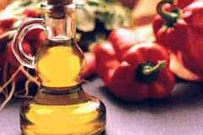

Olive Oil & You
Mediterranean Cooking
OLIVE OIL AND MEDITERRANEAN COOKING
The cornerstone of Mediterranean cooking is olive oil. It is also consumed in daily diets, cooked or uncooked using various techniques. Good uncooked olive oil allows the flavours and aromas of the rest of the ingredients in the dish to shine. Many claim that it takes more skill to cook a dish made with oil than any other high-class gastronomic and complex preparation.
 Uncooked
Uncooked
Extra virgin olive oil has strong organoleptic features, making it is ideal for salads or with vinegar or lemon. Use it with:
- Fresh boiled vegetables, wild greens, boiled or roasted potatoes, peppers, zucchini, cauliflower, broccoli, notchweeds, black nightshades, black mustard, and chicories.
- Complex salads made with potatoes, bread, aubergines, garlic, parsley and fish roe
- Raw or grilled cheese with oregano, savoury, or thyme
- Boiled meat or poultry.
- Rusks, especially barley ones, or on toasted bread
- Marinades for fish and meat
- Aromatic herbs and greens
In the oven
- Olive oil has the ability to keep meat, fish, and vegetables tender in the oven.
- Olive oil mixes well with butter or margarine, especially in foods and desserts that are oven-baked.
- For desserts, oil keeps cakes moist and gives biscuits and cookies a crisp texture.
- Olive oil can be used as a non-stick substance in baking pans.
Barbecues and grill
Put the meat, poultry, fish, and vegetables in marinades with aromatic greens, spices, and olive oil. You can also baste the food with oil before barbecuing or grilling. The taste will improve, the food won’t stick to the grid or turn black, and it will achieve a nice brown colour.
Casserole
Traditional Mediterranean cooking has dozens of casserole dishes. The main ingredients are olive oil, vegetables, wild greens, legumes, meat, potatoes, or pasta. Casserole dishes cooked with olive oil demand great attention, due to the relationship between olive oil and water. It’s good to stew them at a low temperature and with the casserole lid open, so that the water evaporates to leave the dish with only the oil.
Sautéeing
Olive oil has come into its own for health reasons. People (including chefs) suggest sautéeing with extra virgin olive oil.
 Frying
Frying
Olive oil is a great oil for cooking. Strong flavored olive oils can be used for frying fish or other strong flavored ingredients. Olive oil has a high smoke point, 210º C and doesn't degrade as quickly as many other oils do with repeated high heating.
Use a variety of healthy vegetable oils when preparing food and incorporate a good extra virgin olive oil when you want its health benefits and wonderful Mediterranean flavour.
When heated, olive oil is the most stable fat, which means it stands up well to high frying temperatures. Its high smoking point (210º C) is well above the ideal temperature for frying food (180º C). The digestibility of olive oil is not affected when it is heated, even when it is re-used several times for frying.
| TEMPERATURE | TYPE OF FOOD |
|---|---|
| Medium (130–145º C) | High water content: vegetables, potatoes, fruit… |
| Hot (155– 170º C) | Coated in batter, flour or breadcrumbs, forming a crust |
| Very hot (175–190º C) | Small, quickly fried: small fish, croquettes |